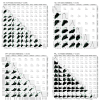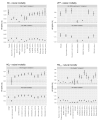Comparison of Long-Term Air Pollution Exposure from Mobile and Routine Monitoring, Low-Cost Sensors, and Dispersion Models
- PMID: 40405483
- PMCID: PMC12099207
Comparison of Long-Term Air Pollution Exposure from Mobile and Routine Monitoring, Low-Cost Sensors, and Dispersion Models
Abstract
Introduction: Assessment of long-term exposure to outdoor air pollution remains a major challenge for epidemiological studies. One of these challenges is characterizing fine-scale spatial variation of the ambient concentrations of key traffic-related air pollutants - including ultrafine particles (UFPs), black carbon (BC), and nitrogen dioxide (NO2). Epidemiological studies have used widely different approaches to address these challenges, including empirical land use regression (LUR) models based on fixed-site routine or targeted monitoring, low-cost sensor networks, mobile monitoring, and deterministic dispersion models. Little information is available about the relative performance of these different approaches for assessing long-term exposure to traffic-related air pollution. Different methods may result in heterogeneity in health effect estimates from epidemiological studies applying different exposure-assessment approaches.
The Specific Aims of the study.
1. Develop long-term ambient air pollution exposure estimates for selected epidemiological studies based on low-cost sensors, mobile and fixed-site monitoring, and deterministic dispersion modeling.
2. Compare different exposure assessment methods in terms of their ability to predict spatial variation of long-term average concentrations using external validation data.
3. Compare different exposure assessment methods in terms of air pollution effect estimates in selected epidemiological studies.
We assessed UFPs, NO2, BC, and particulate matter ≤2.5 μm in aerodynamic diameter (PM2.5).
Methods: We evaluated annual average air pollution concentrations across the Netherlands using a suite of different exposure models, which differed in modeling approach (empirical LUR, deterministic dispersion models) and monitoring data used (low-cost sensors, mobile monitoring, nationwide and Europewide routine monitoring, and study-specific targeted monitoring). For empirical models, we tested three model development algorithms: supervised linear regression (SLR), Random Forest, and least absolute shrinkage and selection operator (LASSO). The predictions of the models were compared at 20,000 addresses across the Netherlands. The performance was also tested on external validation data, which were obtained from a new campaign (2021-2023) and existing data from different years, allowing assessment of how well recent models predict past air pollution exposure. Epidemiological analyses in three cohort studies were conducted to compare health effect estimates of the different exposure models. We assessed associations of air pollution in a national administrative cohort with natural-cause and cause-specific mortality, in a cohort study that had detailed lifestyle data with natural-cause mortality and incidence of stroke and coronary events, and in a mature birth cohort with lung function and asthma incidence.
Results: Exposure predictions at residential sites from the dispersion model and the Europewide hybrid LUR models were available for multiple years in the period 2010-2019. For these models, exposure predictions of different years in the period 2010-2019 were highly correlated for BC, NO2, and PM2.5 (Correlation coefficient R > 0.9). Consistently, the year of the exposure model did not affect the presence of an association with mortality and morbidity. Small differences in hazard ratios (HR) were related to exposure contrast for different years. The HR for the association of NO2 with natural-cause mortality was 1.026 (95% confidence interval [CI]: 1.022-1.031) for the 2010 exposure estimate and 1.030 (1.024-1.035) for the 2019 exposure estimate of the Europewide LUR model, expressed per 10 µg/m3.
The exposure models generally resulted in highly to moderately correlated exposure predictions at residential sites across the Netherlands (R > 0.7 for BC, NO2, and UFPs; R > 0.5 for PM2.5). The predicted level of exposure and exposure contrast could differ substantially between models and algorithms within models; for example, the interquartile range (IQR) for BC for each of the various models at the 20,000 residential locations ranged between 0.1 and 2.2 µg/m3. Mobile monitoring studies generally resulted in modestly higher BC concentrations and exposure contrasts compared to other exposure models. Small differences were found between the different models in explaining the spatial variation of air pollution concentrations at the new and existing validation sites. Models explained historical exposure patterns at external sites covering more than 10 years moderately well, especially for BC (R > 0.7) and NO2 (R > 0.7), and moderately so for UFPs (R > 0.5). Most models predicted the small concentration contrasts of PM2.5 relatively poorly.
Consistent with the high correlation of the different exposure models, the application of these models generally resulted in similar conclusions on the presence of associations with natural-cause, respiratory, and lung cancer mortality in the large nationwide cohort, and with asthma incidence and lung function in the birth cohort. However, the effect estimates differed substantially; for example, the HR for natural-cause mortality in the nationwide administrative cohort for a 1 µg/m3 increase in BC ranged from 1.01 (95% CI: 0.99-1.02) to 1.09 (1.07-1.10). For the outcomes with small effect estimates and the smaller cohort studies, differences in conclusions related to the exposure assessment method were more distinct.
Differences in exposure assessment may contribute substantially to the observed heterogeneity of effect estimates in systematic reviews of epidemiological studies. High heterogeneity was indicated by the commonly used heterogeneity measure I2, where the value was above 80% for a meta-analysis of the different effect estimates for natural-cause mortality in the nationwide cohort.
Validation of long-term exposure models for the nonroutinely monitored pollutants BC and especially UFPs was challenging, despite generally successful monitoring. The new external validation monitoring campaign resulted in rather unstable estimates of the long-term average spatial contrast, both across sites and where affected by temporal variation, especially for BC and PM2.5.
No consistent differences were found in the model performance of SLR, Random Forest, and LASSO, both in internal cross-validation of model building and on external validation sites not used in model building. Exposure predictions from the three algorithms were generally highly correlated and resulted in similar associations with health. However, for individual models, occasionally large differences were found in exposure contrast, validation statistics, and associations with mortality and morbidity outcomes.
There was little benefit in using low-cost sensors for NO2 and PM2.5. The addition of low-cost sensor data did not improve NO2 estimates in models that combined dispersion model estimates and data from the national monitoring network data.
Conclusions: The main conclusions of the project.
• Exposure predictions of BC, NO2, and PM2.5 for different years between 2010-2019 were highly correlated, documenting stable spatial contrast patterns. Consistently, the year of the exposure model did not affect the presence of an association with mortality and morbidity outcomes.
• Models explained historical exposure patterns at external sites covering more than 10 years moderately well, especially for BC.
• Different exposure models generally resulted in highly to moderately correlated exposure predictions. The predicted level of exposure and exposure contrast could differ substantially between models. Small differences were found between the different models in explaining spatial variation at validation sites.
• Application of different exposure models resulted in similar conclusions about the presence of associations with health outcomes, but effect estimates differed substantially in magnitude between individual exposure models. No consistent differences in effect estimates were found between groups of mobile, dispersion, and fixed-site LUR models.
• Differences in exposure models may therefore contribute substantially to the observed heterogeneity of effect estimates in systematic reviews of epidemiological studies. Factors that explained some of the heterogeneity of effect estimates included the performance of the model at external validation sites and the predicted exposure contrast.
• Exposure predictions from the three algorithms were generally highly correlated and resulted in similar associations with health. No consistent differences were found in their model performances.
© 2025 Health Effects Institute. All rights reserved.
Figures
































Similar articles
-
Mortality and Morbidity Effects of Long-Term Exposure to Low-Level PM2.5, BC, NO2, and O3: An Analysis of European Cohorts in the ELAPSE Project.Res Rep Health Eff Inst. 2021 Sep;2021(208):1-127. Res Rep Health Eff Inst. 2021. PMID: 36106702 Free PMC article.
-
Long-Term Exposure to Outdoor Ultrafine Particles and Black Carbon and Effects on Mortality in Montreal and Toronto, Canada.Res Rep Health Eff Inst. 2024 Jul;2024(217):1-63. Res Rep Health Eff Inst. 2024. PMID: 39392111 Free PMC article.
-
Characterizing Determinants of Near-Road Ambient Air Quality for an Urban Intersection and a Freeway Site.Res Rep Health Eff Inst. 2022 Sep;2022(207):1-73. Res Rep Health Eff Inst. 2022. PMID: 36314577 Free PMC article.
-
Assessing Adverse Health Effects of Long-Term Exposure to Low Levels of Ambient Air Pollution: Implementation of Causal Inference Methods.Res Rep Health Eff Inst. 2022 Jan;2022(211):1-56. Res Rep Health Eff Inst. 2022. PMID: 36193708 Free PMC article. Review.
-
Short-term exposure to particulate matter (PM10 and PM2.5), nitrogen dioxide (NO2), and ozone (O3) and all-cause and cause-specific mortality: Systematic review and meta-analysis.Environ Int. 2020 Sep;142:105876. doi: 10.1016/j.envint.2020.105876. Epub 2020 Jun 23. Environ Int. 2020. PMID: 32590284
References
-
- Apte JS, Messier KP, Gani S, Brauer M, Kirchstetter TW, Lunden MM, et al. . 2017. High-resolution air pollution mapping with Google Street View cars: exploiting big data. Environ Sci Technol 51:6999–7008, https://doi.org/10.1021/acs.est.7b00891. - PubMed
-
- van de Beek E, Kerckhoffs J, Hoek G, Sterk G, Meliefste K, Gehring U, et al. . 2021. Spatial and spatiotemporal variability of regional background ultrafine particle concentrations in the Netherlands. Environ Sci Technol 55:1067–1075, https://doi.org/10.1021/acs.est.0c06806. - PMC - PubMed
-
- Beelen R, Hoek G, Vienneau D, Eeftens M, Dimakopoulou K, Pedeli X, et al. . 2013. Development of NO2 and NOx land use regression models for estimating air pollution exposure in 36 study areas in Europe: the ESCAPE project. Atmos Environ 72:10–23, http://dx.doi.org/10.1016/j.atmosenv.2013.02.037.
-
- Blanco MN, Doubleday A, Austin E, Marshall JD, Seto E, Larson TV, et al. . 2023a. Design and evaluation of short-term monitoring campaigns for long-term air pollution exposure assessment. J Expo Sci Environ Epidemiol 33:465–473, https://doi.org/10.1038/s41370-022-00470-5. - PMC - PubMed
-
- Blanco MN, Bi J, Austin E, Larson TV, Marshall JD, Sheppard L. 2023b. Impact of mobile monitoring network design on air pollution exposure assessment models. Environ Sci Technol 57:440–450, https://doi.org/10.1021/acs.est.2c05338. - PMC - PubMed
Publication types
MeSH terms
Substances
LinkOut - more resources
Full Text Sources
Medical
Miscellaneous
